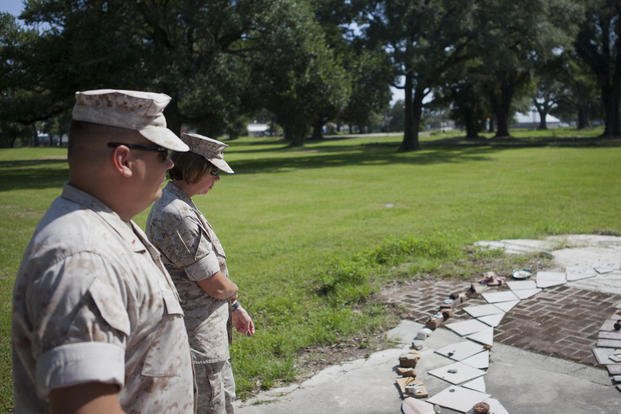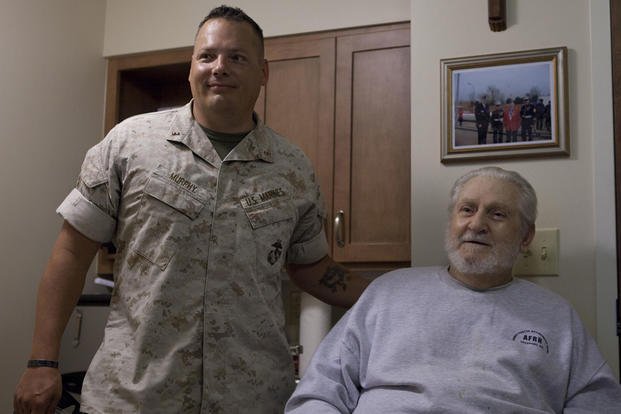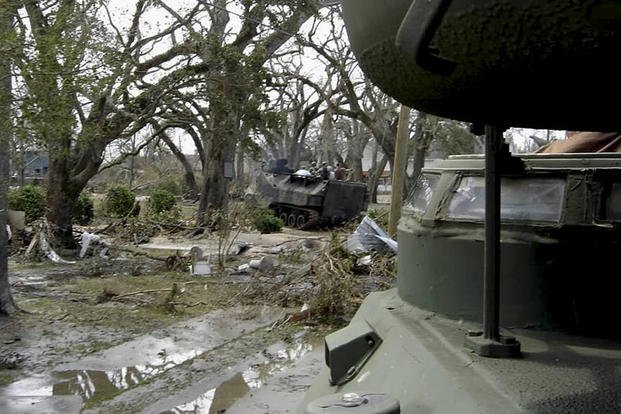GULFPORT, Miss. -- The coastline of southern Mississippi was lined with large, historic houses with lush green yards and tall palm trees. Families had owned houses along the coast for many decades, each with a front walkway and stairs leading to their grand house. There was a charm about the area.
Ten years after Hurricane Katrina devastated the area Aug. 29-30, 2005, the coastline is lined with empty lots open for sale. The lots have an overgrown front walkway with worn stairs leading to a slab where a grand house once stood. The coastline has been altered forever.
Staged in a building dubbed the “round house” at Naval Construction Battalion Center, Gulfport, Mississippi, a reaction team of six Marines and two sailors awaited for the mission to help others using amphibious tractors as Hurricane Katrina approached the Gulf Coast late at night Aug. 28, 2005.
“We’d peak out every once in awhile and saw cars being rocked and windows being blown out,” said Master Sgt. Shannon Sweeney, operations chief, ordnance officer and Inspector-Instructor for Combat Logistics Battalion 451. “We could see the commissary; the hurricane was tearing it up. That is when I realized ‘this is no joke.’”
Sweeney, who was a staff sergeant at Naval Construction Battalion Center working as the armorer for the I-I staff during Hurricane Katrina, had just moved to Mississippi. She was part of the base reaction team for disasters during Hurricane Irene earlier in August 2005. The reaction team had just sat around and wasn’t called to assist during Irene.
As conditions worsened during Katrina, the reaction team became anxious to assist the community.
“I talked with the base commander about what the AMTRACs were capable of,” said Chief Warrant Officer 4 Jerod Murphy, assistant ordnance officer for the 1st Marine Division. “The base was somehow receiving information from the police department that civilians were in distress. The base commander gave us keys to the Pass Road Gate, so we left out the gate, locked it behind us and headed toward the Biloxi, [Mississippi] Police Department.”
AMTRACs are amphibious vehicles with tank-like tracks, making the vehicles able to maneuver over debris, according to Murphy.
During the late hours of Aug. 28, 2005, the reaction team, led by Murphy, a staff sergeant serving as the maintenance chief for the AMTRACs at the time of Hurricane Katrina, headed into the pitch-black night. The team was guided by the headlights from their two AMTRACs with only communication devices. The team navigated their way down the road toward the Biloxi Police Department.
“Just driving down Pass Road was a surreal environment,” said Murphy. “The road was empty with very few people. The rain [and] wind was insane. Every traffic signal was flip-flopping all over the place. It was pretty intense.”
Navigating their way over downed power lines, broken gas lines and guessing where the street was buried under the gathering debris, the team found their way to the police department. The leaders of the team met with the police and headed to neighborhoods in the east side of the city that were in bad shape. The streets were impassable for all vehicles, except the AMTRACs.
Related Video
Semper Fi Always Faithful
“We started looking for folks,” said Murphy. “We found a bunch of folks in a Buddhist temple trying not to float away, so we packed our vehicles full of those folks. We made a couple trips back to get everyone out and took all the folks to a relief center in the city. We swept the city as much as we could trying to ensure everyone who needed rescuing was rescued.”
Murphy’s team, which worked into the early hours of Aug. 29, was the only asset in the area capable of rescuing the local citizens at the time of the hurricane. Before heading out on another mission, the team was able to sleep for two to three hours while the hurricane still raged.
“The waves came in approximately a quarter of a mile and rose to 35 feet high at times,” said Sweeney. “You just couldn’t imagine that wind and water could take houses away. Some structures were still standing, while others were completely demolished. It was weird to see the houses turned to rubble. The wind was probably blowing 70-100 miles per hour.”
The team navigated their way to the Armed Forces Retirement Home in Gulfport where some residents had fallen down the stairs retreating to the higher floors to escape the water. The injured veterans were evacuated to the hospital for medical attention. This was the same veteran’s home Murphy visited regularly to share meals with Marine veterans, particularly his friend John Morash Sr., a retired Marine veteran. The home was so heavily damaged from the hurricane that in 2010, a brand new, larger complex opened on the same property and is now home to hundreds of veterans.
“When one of the older men got out of the AMTRAC at the hospital he was so excited and said, ‘I had always wanted to ride on an AMTRAC; I just didn’t think it would be under these circumstances,’” said Murphy. “The veterans were extremely grateful. The commissary had been unlocked for us, so we took them water and whatever we could carry.”
The team moved westward to the city of Pass Christian to transport the police chief and fire chief downtown to make an assessment of the people who needed rescuing. The destruction of the storm was so bad that there was no way to get to a senior living complex on the shoreline from land. The team went behind the complex and made an amphibious landing up on the beach.
“The entire first floor of the complex was gone,”said Murphy. “We picked up anyone we saw and got them out of there.”
Today, the senior living complex still stands but is a skeleton of a building and sits on the shoreline in ruin. The complex overlooks the ruins of a lonely neighborhood without houses or families, but piles of bricks and rubble can still be seen through the grassy fields lined by broken sidewalks where a family once lived.
During the first 48 hours, the reaction team was credited with rescuing 202 people. The fourth day after the hurricane, the team was reassigned to assist the people of Louisiana.
“After speaking with leadership of the Federal Emergency Management Agency personnel located at the John C. Stennis Space Center, we were assigned a mission to help search and rescue teams in Louisiana,” said Murphy. “The teams had cadaver dogs and we joined them on foot to recover human remains.”
As the days past, residents made their way back to their homes. Some residents came back to a slab, a pile of rubble or a damaged house.
“A few days later when people were allowed to come back and were trying to look for their stuff, that was probably the worst,”said Sweeney. “Some people came back to nothing. I would not know what to do if I lost pictures because you can’t get them back.”
The smells left during the days, weeks and months following Katrina became strong, amplified by the heat and humidity of the South’s summer weather.
“The smells of the hurricane are some of the strongest memories because everything rotted,” said Jean Sammons, lead disaster case manager of Fleet and Family Support Center at Naval Construction Battalion Center, Gulfport, and was a volunteer at the FFSC in August 2005. “We have barrier islands off the coast. Those islands were full of wildlife that all washed off and drowned and now they are embedded in our debris. We had a marine life park; a lot of those animals were also washed ashore. There’s no garbage service; because there is no way to get the trucks in, so there is no outgoing debris.”
After returning from missions, the reaction team had a hose hooked up to provide cold water showers.
“It was nasty coming back from missions,” said Murphy. “We were walking through some hazardous material. You were covered in mud and who knows what. There were caskets that floated up during the storm. The days following the storm we were walking through thick muck that came up to our waists at times.”
Insurance for homeowners has changed since Katrina, specifically in Mississippi. Most people can’t rebuild their houses because they can’t get insurance. Many people still own the land where their house once stood, but without insurance they would risk everything.
Today the neighborhoods near the coast have very few houses. The houses that are built are elevated off the ground. Most neighborhoods are desolate with neglected streets, run down sidewalks, and crumbling front walks and stairs leading to lonely overgrown grass fields. Yet, the area is clear of debris with residents living life as normal and tourists enjoying the culture of the southern Mississippi coast.
“Everybody did a great job taking care of each other here in Mississippi,” said Sammons. “I’m proud that we didn’t lose one person attached to the installation. The loss of life was zero, which is remarkable considering what happened.”































